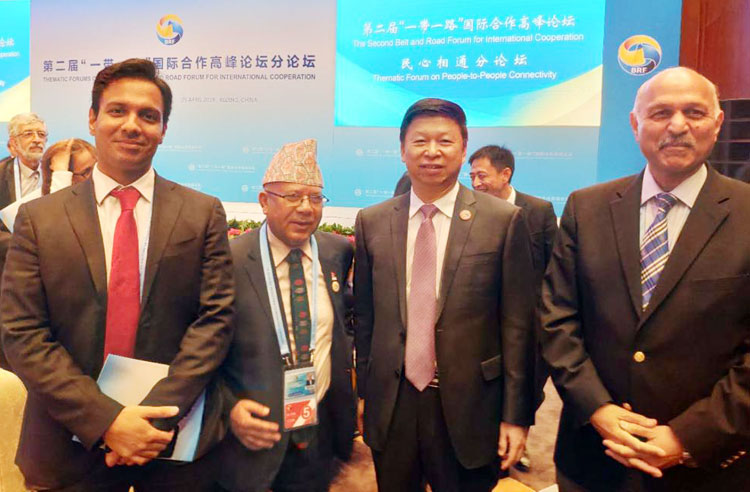
Written by: Senator Mushahid Hussain Sayed
Posted on: May 02, 2019 |  | 中文
| 中文
Prime Minister of Pakistan, Imran Khan with President of China, Xi Jinping
No one event exemplifies the inexorable shift of the centre of global gravity from the West to the East than the biggest global gathering that convened in Beijing for the Forum of the Belt & Road Initiative (BRI) last week. The first such BRI Forum took place in May 2017, with the attendance of 29 leaders. This time, 37 foreign leaders, presidents and prime ministers, attended including, for the first time, the Prime Minister of a G-7 country, Italy. Presidents of Russia, Chile, Czech Republic, the Philippines and Prime Ministers of Pakistan and Malaysia were amongst the prominent invitees.
The Belt & Road Forum (BRF), with a total attendance of 5000 representatives from over 150 countries and international organisations, who participated in 12 different thematic sessions, had a three-fold significance.
First, the BRF was held amidst the historic transition in the global balance of economic, cultural and political power from the West to the East, with the West including the United States and Europe in relative decline and even disarray, as opposed to the vigour and dynamism exuded in resurgent Asia. Beijing is today a more “happening” place than Washington, London or Brussels. As President Xi Jinping confidently asserted in his inaugural address to the BRF on April 26: “We Chinese have stood up and hold our future in our own hands”.
Second, the BRI, as the most significant developmental and diplomatic initiative of the 21st century today, is the principal driver of globalization, spanning 6 corridors spread over 70 countries of Asia, Africa, Europe and the Middle East, which comprise 70% of the world’s population, 55% of the global GDP and nearly 25% of global trade. The scale, size and speed of the BRI, launched just five years ago, is simply breathtaking. 30% of global growth is being fueled by China.
Third, the central theme of the 2019 BRF was in congruence with one of the biggest challenges faced by humanity, namely, Climate Change. With the theme of “Green and Clean BRI”, BRF underlined the importance of “Green Development” and President Xi Jinping called for launching “green infrastructure projects, make green investment and provide green financing to protect the Earth which we all call home”. In other words, China has also taken up the cudgels against Climate Change, filling a leadership vacuum following the American withdrawal from the Paris Climate Change Accord.
With the China Pakistan Economic Corridor (CPEC) retaining its pivotal role as the flagship and pilot project of the BRI, Pakistan had proactive participation in the BRF. For Pakistan, since CPEC is already a success story reaching the completion of the first phase, the BRF actually launched the second phase of CPEC.
In the first phase of CPEC, under the BRI, China has invested $19 billion in 22 Early Harvest Projects (EHPs) including energy, infrastructure and the development of Gwadar Port. 70,000 Pakistanis are gainfully employed in Chinese-funded projects, while 28,000 Pakistanis are now studying in China.
The second phase of CPEC has 3 priorities, mutually agreed upon by Pakistan and China:

While the BRI seeks the revival of the ancient Silk Road, the initiatives are not all about brick and mortar, but these also have a strong cultural component. President Xi Jinping in his speech to the BRI Forum in 2017 also referred to this aspect of the role of the Silk Road, saying that “the ancient Silk routes were not about trade only, they boosted the flow of knowledge as well and they connected the lands of Buddhism, Christianity and Islam.”
The BRF also announced “multi-faceted people-to-people cooperation” with initiatives to promote exchanges in education, culture, sports, tourism, and archaeology, with participation of political parties and think tanks, and institutional arrangements that include an International Youth Forum, the Silk Road Think Tanks Network (SiLKS), the Silk Road International Library Alliance, the Silk Road International Alliance of Art Museums & Galleries, the BRI Studies Network and the BRI News Alliance.
The global impact of BRI is underlined by the 2017 joint report issued by the UNDP and China Center for International Economic Exchanges, which suggested that the BRI ‘could serve as an accelerator and an effective enabler to achieve the Sustainable Development Goals (SDGs)’. The message from the historic BRF is clear: winds of change are sweeping across the global horizon with Asian hands shaping the future and destiny of Asia, inextricably woven together by the new world opening through corridors, culture and connectivity spanning countries, continents and civilisations.
You may also like: